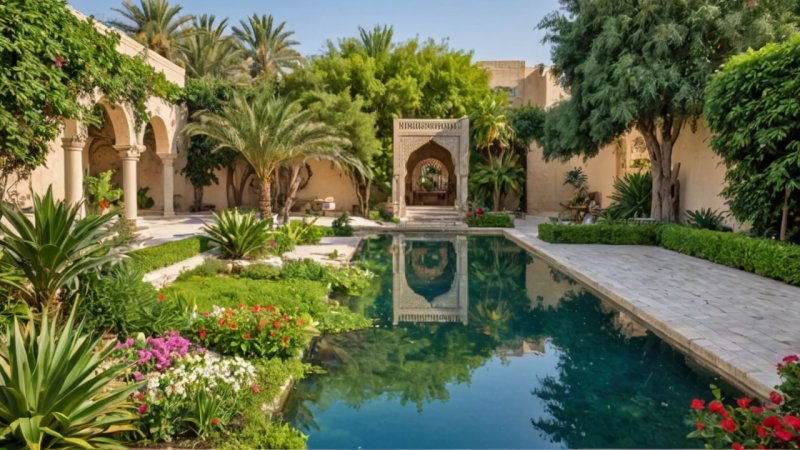The Middle East, often recognized for its historic landmarks and vibrant cultures, also harbors a treasure trove of hidden gardens that offer a serene escape from the bustling cities and arid landscapes. These gardens are not merely patches of greenery; they are sanctuaries of tranquility, history, and biodiversity, reflecting the rich heritage and artistry of the region. From the lush oases of Oman to the enchanting gardens of Iran, the Middle East is home to some of the most breathtaking hidden gardens that provide both locals and travelers a unique experience of nature intertwined with culture. This article delves into the specific hidden gardens in various Middle Eastern countries, exploring their history, significance, and travel tips to fully appreciate these verdant havens.
The Botanical Wonders of Oman
Oman, known for its dramatic landscapes ranging from mountains to deserts, also hosts some lesser-known botanical gems. The gardens here often blend traditional Omani architecture with lush flora, creating an inviting atmosphere.
Al Ain Oasis
Located near the border with the UAE, Al Ain Oasis is a UNESCO World Heritage site celebrated for its falaj irrigation system, which has been in use for over 3,000 years. Visitors can stroll through its date palm groves, which offer a refreshing respite from the sun. The cool pathways and shaded areas make it an ideal spot for relaxation.
Muscat’s Royal Gardens
The gardens surrounding the Sultan Qaboos Grand Mosque in Muscat are a must-visit. While the mosque itself is a major attraction, the gardens are often overlooked. They feature beautifully manicured lawns, fountains, and a variety of local flora. The tranquil environment makes it a perfect place for reflection and photography.
The Lush Landscapes of Iran
Iran's gardens are steeped in history, often reflecting the Persian philosophy of paradise on earth. Many of these gardens date back to the Safavid era and incorporate intricate designs that symbolize nature's harmony.
Fin Garden
Located in Kashan, the Fin Garden is one of the most famous Persian gardens. This UNESCO World Heritage site is renowned for its symmetrical layout, featuring fountains, pools, and cypress trees that create a picturesque landscape. Visitors can explore the historical bathhouses adjacent to the garden, which adds a cultural layer to the experience.
Shazdeh Garden
Another gem is the Shazdeh Garden in Mahan, which is celebrated for its unique design and lush greenery amidst the desert. The garden is laid out on a slope, creating a cascading effect that enhances its beauty. The combination of water features and colorful flowers makes it a breathtaking sight, particularly in spring.
Secret Spots in Lebanon
Lebanon's rich history and biodiversity are reflected in its hidden gardens, which often serve as peaceful retreats from the bustling urban life.
Beiteddine Palace Gardens
The gardens of Beiteddine Palace, located in the Chouf Mountains, are a stunning example of landscape architecture. Visitors can enjoy the fragrance of various flowers and the sight of towering cypress trees while wandering through the meticulously maintained grounds. The palace itself is a masterpiece of Lebanese architecture, providing a cultural context to the natural beauty.
The Lebanese Heritage Garden
Situated in the heart of Beirut, this garden showcases the biodiversity of Lebanon. It features native plants and trees, making it both an educational and relaxing space. The garden is a testament to the country's commitment to preserving its natural heritage amidst urban development.
Jordan’s Desert Oasis
Jordan may be known for its archaeological wonders like Petra, but it also boasts hidden gardens that tell stories of resilience and the beauty of life in arid regions.
The Royal Botanical Garden
Located near the capital city of Amman, this garden is an effort to preserve Jordan’s native plants. It features a wide array of flora that represents the country’s diverse ecosystems. The garden is an excellent spot for nature lovers and those looking to understand more about sustainable practices in the region.
Al-Maghtas Gardens
Near the site believed to be the Baptism of Christ, the gardens of Al-Maghtas are a peaceful retreat. The area is rich in history and offers stunning views of the Jordan River. Visitors can enjoy picnicking in the shade of ancient trees while soaking in the serene atmosphere.
Travel Tips for Visiting Hidden Gardens
Exploring the hidden gardens of the Middle East can be a rewarding experience, but here are some tips to enhance your visit:
- Respect the Environment: Many gardens are home to rare species, so be mindful of your surroundings and avoid picking plants.
- Visit During Off-Peak Times: To enjoy the tranquility of these spaces, plan your visit early in the morning or late in the afternoon.
- Local Guides: Consider hiring a local guide who can provide insights into the history and significance of the gardens.
- Photography Etiquette: Always ask for permission before taking photos of people or sacred sites within the gardens.
- Dress Appropriately: Many gardens in the Middle East are located near religious sites, so dress conservatively out of respect.
Conclusion
The hidden gardens of the Middle East offer a unique glimpse into the region's rich cultural tapestry and natural beauty. From the lush landscapes of Oman to the historical gardens of Iran and Lebanon, these oases provide a peaceful escape for travelers seeking solace and reflection. As you plan your journey through this diverse region, make sure to include these hidden gems in your itinerary. They are not just places to visit; they are experiences that connect you to the heart of the Middle East's heritage and environment.






